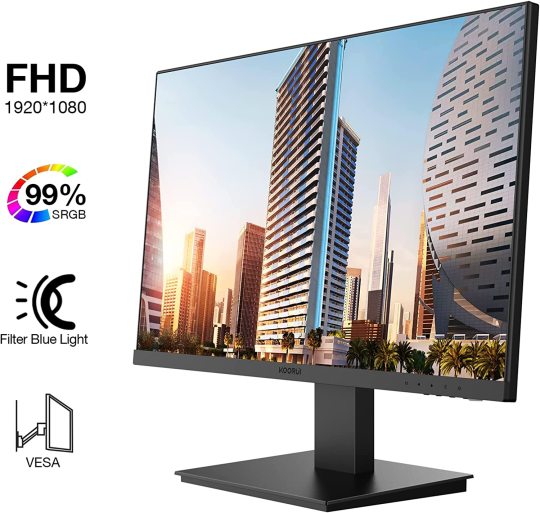Text

koorui 24 inch business computer monitor
When choosing a monitor for home office use, there are several important factors to consider. The best monitor for some may not be the best monitor for your home office setup.
1. Size of the Monitor
A large display will give you more space to work with, but it may be more expensive and take up more desk space. Some workers such as graphic designers or video editors may need a larger screen than someone in finance. The size of the computer monitor should be based on what you need it to do.
2. Resolution
A higher resolution will make text and images look sharper, but it may also cause eye strain after long periods of use.
3. HD Monitors
Full HD (1080p) have resolutions of 1920×1080 pixels and is a good choice for general use. For example, this koorui 24 inch business computer monitor is the desktop monitor I am using now. It is a HDMI monitor with HDMI ports and one VGA port provide up to 75HZ refresh rate.B09FLD6XK9
Quad HD Monitors (1440p) have resolutions of 2560×1440 pixels and are better suited for users who need more screen real-estate or sharper image quality.
Ultra HD Monitors (2160p) have resolutions of 3840×2160 pixels and offer the highest image quality, but are also the most expensive.
4. Refresh Rate
A monitor’s refresh rate is how often the image on the screen is updated per second and is measured in Hertz (Hz). A higher refresh rate will result in a smoother image, but may not be noticeable to the naked eye.
For general use, a 60Hz monitor is fine. Gamers, graphic designers, or video editors who need a very smooth image may want a monitor with a higher refresh rate of 75Hz, 100Hz, 144Hz, or even 240Hz.
5. Color Accuracy
If you’re working with graphics or doing any type of color-critical work, you’ll want a monitor that can display colors accurately. Most monitors have decent color accuracy out of the box, but some are better than others. You can usually improve color accuracy by calibrating your monitor, but it’s still something to keep in mind when you’re choosing which one to buy.
6. Anti-Glare Screen
An anti-glare screen can help reduce eye strain but may cause the image to appear less sharp.
If you spend long hours looking at your computer monitor and do not require sharpness for your day-to-day work, this screen may be a good option for you.
7. Portable Monitor
A portable monitor is a good choice if you need to work on the go or do not have a lot of desk space.
Most portable monitors are small, lightweight, and have built-in batteries so they can be used without being plugged into an outlet.
Some portable monitors even come with a stand so they can be propped up like a regular monitor.
8. Touchscreen Monitor
A touchscreen monitor can be a good choice if you want a more interactive experience or need to use specific applications that are designed for touch.
Keep in mind that touchscreen monitors may be more expensive and require special care to clean the screen properly.
9. Ultrawide Monitor
An ultrawide monitor is a good choice if you need more screen real estate or want a more immersive experience.
Ultrawide monitors usually have a 21:9 aspect ratio and are much wider than traditional 16:9 monitors. Some ultrawide monitors even come with built-in speakers and an adjustable stand. Looking for other ultrawide options? Check out our top ultrawide monitor picks!
10. USB Ports
Some monitors come with USB ports that can be used to connect devices such as a mouse, keyboard, or flash drive.
If you need to use USB ports, make sure the monitor you choose has the right number and type of ports for your needs. Some older monitors will have the old USB ports, while other monitors may have the newer USB c port.
Recap and Further Reading
So, what have we learned? First, the best desktop monitors for home office use should be large with a wide viewing angle and a fast response time. Built-in USB ports are not mandatory but can be useful with multiple devices.
Again, the best desktop monitors for one person may not be the best monitors for you because it all depends on how you intend to use your desktop monitor.
1 note
·
View note